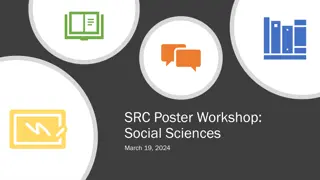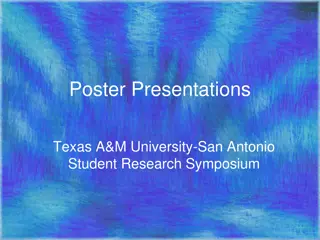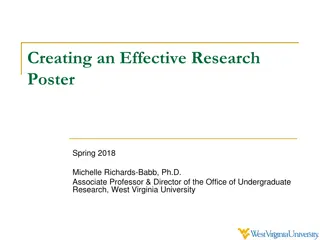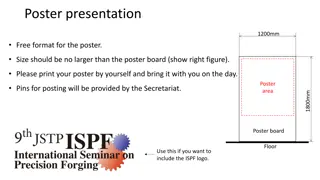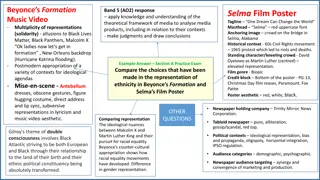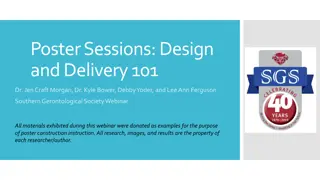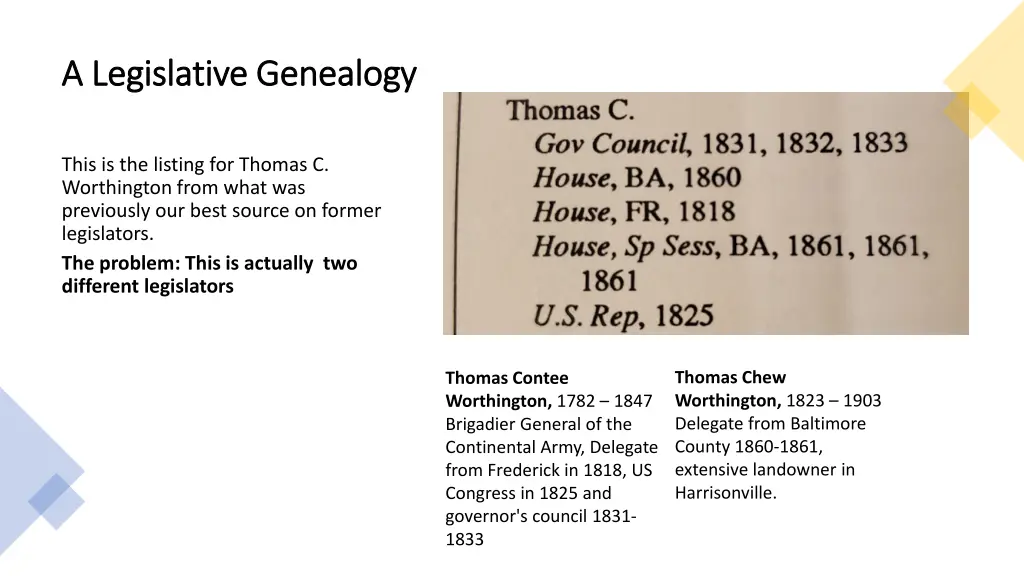
Legislative Genealogy Project Highlights Maryland's Diverse Political History
Dive into the Legislative Genealogy project showcasing the intricate history of Maryland's political landscape through detailed bios of past legislators. Discover fascinating facts, data organization methods, and valuable applications for researchers.
Download Presentation

Please find below an Image/Link to download the presentation.
The content on the website is provided AS IS for your information and personal use only. It may not be sold, licensed, or shared on other websites without obtaining consent from the author. If you encounter any issues during the download, it is possible that the publisher has removed the file from their server.
You are allowed to download the files provided on this website for personal or commercial use, subject to the condition that they are used lawfully. All files are the property of their respective owners.
The content on the website is provided AS IS for your information and personal use only. It may not be sold, licensed, or shared on other websites without obtaining consent from the author.
E N D
Presentation Transcript
A Legislative Genealogy A Legislative Genealogy This is the listing for Thomas C. Worthington from what was previously our best source on former legislators. The problem: This is actually two different legislators Thomas Chew Worthington, 1823 1903 Delegate from Baltimore County 1860-1861, extensive landowner in Harrisonville. Thomas Contee Worthington, 1782 1847 Brigadier General of the Continental Army, Delegate from Frederick in 1818, US Congress in 1825 and governor's council 1831- 1833
The Database The Database Once all available data is gathered, it is entered into an Access table. Different field types (such as hyperlink and Yes/No) were chosen based on the metadata and the desired search functions for the final product. An entry form is used to add new members to the table, which speeds data entry considerably. In addition to the data collected in the various fields, a "Notes" field is used to enter any relevant information that doesn't fit into any of the existing categories, such as notable firsts or exemplary accomplishments
Using the data Using the data A search form allows users to search for members by name, as well as sort them by gender. Having the data stored in this format allows for the expansion of search options in the future, such as sorting members by county or district. Sources that were once unclear and inaccurate have been fixed, and the data is now searchable. Links to obituary scans allow access to a digital library that was previously unavailable.
Applications New, up-to-date authoritative resource for Maryland politics. Most recent resource is 31 years old and involved little to no identity verification. Valuable research resource for political science and history researchers. Model project for developing internal research resources, especially data that is specific to the history of an institution and will likely not be compiled elsewhere. Model digitization project for turning an analog resource into a new format that allows for more robust searching. Demonstration of nontraditional use of an electronic resource that would normally have little to no use for our needs. Will serve as a tool for organizing future research into the General Assembly membership, allowing for compiling and cross-referencing of data.
Fun Finds Montgomery Blair (1878, Montgomery County) represented Dred Scott in his Supreme Court case In 1845, Alexander Somerville (1832, Calvert) was shot through his living room window by one of his enslaved people in an attempted escape Charles Rose of Talbot County served as a Democrat in 1868, then as a Republican 42 years later in 1910. Moses Rose (Baltimore, 1927-1930) was arrested for violations of the Volstead Act during his term when it was found he was producing alcohol in his store. Nathaniel Rochester (Washington County, 1790) served in the North Carolina Assembly before moving to Maryland, then moved to upstate New York, founding the city of Rochester. At least three (3) members of the General Assembly have faced murder charges So far, at least 26 members were known to have served in the Confederate Army or Navy, including Carlton Shafer (Frederick 1886) who led a company of cadets from Virginia Military Institute into the Battle of New Market
Maryland Legislative Library Department of Legislative Services Office of Policy Analysis 90 State Circle Annapolis, MD 21401 Richard Sigwald Richard.sigwald@mlis.state.md.us Elizabeth Bateman Elizabeth.bateman@mlis.state.md.us



